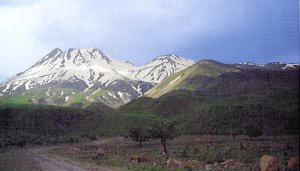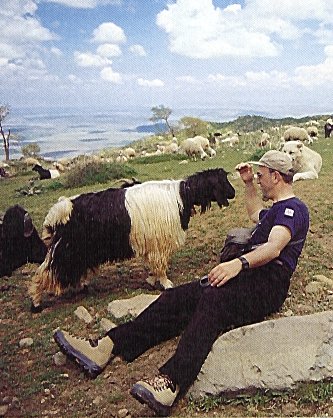 Hasandağ (Mount Hasan)
Hasandağ (Mount Hasan)
 High peaks within large mountain systems, set amidst a
scattering of more humble summits, are like kings or lords surrounded by their retinues.
But most volcanoes are not like that. In their solitary splendour they are far more
striking as anyone who has seen a photograph of Fujiyama in Japan will know. However high
they might be they are always alone, and you can feel this fact whether looking upon them
from afar or climbing on the mountain itself. And when you go to Hasandağ you feel this
loneliness with extraordinary intensity. High peaks within large mountain systems, set amidst a
scattering of more humble summits, are like kings or lords surrounded by their retinues.
But most volcanoes are not like that. In their solitary splendour they are far more
striking as anyone who has seen a photograph of Fujiyama in Japan will know. However high
they might be they are always alone, and you can feel this fact whether looking upon them
from afar or climbing on the mountain itself. And when you go to Hasandağ you feel this
loneliness with extraordinary intensity.
Looking from the west the mountain rises in a single and perfect cone from the flat
central Anatolian plateau. Approaching from Ankara to the north-west on a sufficiently
clear day the mountain is visible from a distance of 60 kilometres, and as you draw nearer
the view becomes increasingly spectacular. We had been planning to climb this magnificent
mountain just south of Aksaray on the Ankara-Adana road for a long time and one May day we set out. The month of
May is probably the loveliest time of the year everywhere in Turkey , but for the
Anatolian plateau with its freezing winters and blazing hot summers, this month is
undoubtedly the loveliest, an exquisite interval when the gray-brown steppe rolling into
the distance is transformed into a brilliant green.
We got out of our car at the village of Yukarı Dikmen amidst just
such greenery. At an altitude of around 1700 the three of us put on our backpacks and
began walking. A crowd of children from the village insisted accompanying us for a while
before bidding farewell. At 2000 metres we were alone with our mountain.
As we ascended, the greenery of the lower slopes gradually made way for volcanic
boulders. The trees thinned out and became steadily smaller until finally nothing but a
few spikes of grass remained.
 By
evening we had reached a height of 2600 metres and the landscape was a truly familiar
mountainous one. We set up camp and then watched the sun sink between the clouds,
realizing what it meant to be on a truly lonely volcano. Towards the west the plain far
below stretched out as far as the eye could see. It was like looking down from an
airplane. I was reminded of a wall painting found at Çatalhöyük, one
of the oldest cities in the world dating from 8000 BC. in which Hasandağ, together with
its secondary peak to the east, is depicted with smoke emerging from the summit. It was
hard to believe that this serene mountain had still been erupting at a time when our
prehistoric ancestors were around to witness the event. By
evening we had reached a height of 2600 metres and the landscape was a truly familiar
mountainous one. We set up camp and then watched the sun sink between the clouds,
realizing what it meant to be on a truly lonely volcano. Towards the west the plain far
below stretched out as far as the eye could see. It was like looking down from an
airplane. I was reminded of a wall painting found at Çatalhöyük, one
of the oldest cities in the world dating from 8000 BC. in which Hasandağ, together with
its secondary peak to the east, is depicted with smoke emerging from the summit. It was
hard to believe that this serene mountain had still been erupting at a time when our
prehistoric ancestors were around to witness the event.
The second day began with sunshine. Since we were on the western face of Hasandağ we
watched its triangular shadow fall on the plain. Then we packed up and began to trek over
the snow, which each day melted in the warmth of the spring sunshine and then froze over
once again at night. Towards noon it clouded over and the incline became steep. We no
longer felt like mountain hikers but now faced the business of serious mountaineering. At one point we even considered getting the
ropes out but before long we were at the 3260 metre summit. Later we realized that we had
been lucky, and unknowingly reached the highest point of a crater whose diameter was
approximately 500 metres. Following a tradition on Turkish mountains we found the summit
book and recorded notes about our climb. It was curious to come across a notebook at a
point no one else would be likely to find and to read the account of others as mad as
yourself and write your own account for others who come after you. With all the solemnity
of an ancient ritual of antiquity the three of us signed the book.
As evening was falling on the second day we noticed a patch of snowless ground on an
interesting ridge in the centre of the crater. We mountaineers boast about camping in the
most severe conditions but still do our best to find the most comfortable camping place.
Thousands of years ago the obsidian rocks which might be described as natural volcanic
glass were extremely important materials useful for much more than making decorative
ornaments for the mantle piece. In the stone age before metals were discovered the
sharpest knives arrow heads and even mirrors were made of obsidian and the highest quality
least flawed obsidian in Anatolia and the surrounding region was to be found at Hasandağ.
As early as 7000 BC this precious mineral is known to have been carried on people's backs
to sell at places hundreds of kilometres away. What do three mountaineers talk about when
crowded in a single tent inside the crater of an extinct volcano? Actually the topics of
conversation are not much different from those of people in the cities. The real
difference lies in the speed of speech. Within this narrow space the speed of life is
regulated by the flame of the tiny butane stove. The snow slowly melts the tea simmers
tranquilly and the sausages brown ever so gradually You are not in a hurry to get anywhere
and there is no urgent business to be done. The pressure of time which pursues you
furiously in the city evaporates here overnight. This is a marvelous reward for the
trouble of climbing so high carrying a load of 22 kilos on your back.
 At daybreak
on the third day we set off eastwards. From this direction Hasandağ does not preserve
such a perfect conical shape. Several secondary summits can be seen and beyond them
another mass which almost deserves to be called a separate mountain. Descending rapidly we
piled up our camping equipment between the two mountains. So as to enjoy the hard snow of
the early hours to the full we took only our ice axes and crampons and set off to climb
the second mountain taking a snowy route which seemed to be the steepest. When we reached
the summit and looked northwards all of Cappadocia was spread out below our feet. Perhaps
we would never get the opportunity to see the hidden beauties of the region's narrow
valleys from such a height ever again. We just stood and watched. Half a hour later our
visit was over and we set out downwards again. Hasandağ had proved far more fascinating
than even we had imagined. At daybreak
on the third day we set off eastwards. From this direction Hasandağ does not preserve
such a perfect conical shape. Several secondary summits can be seen and beyond them
another mass which almost deserves to be called a separate mountain. Descending rapidly we
piled up our camping equipment between the two mountains. So as to enjoy the hard snow of
the early hours to the full we took only our ice axes and crampons and set off to climb
the second mountain taking a snowy route which seemed to be the steepest. When we reached
the summit and looked northwards all of Cappadocia was spread out below our feet. Perhaps
we would never get the opportunity to see the hidden beauties of the region's narrow
valleys from such a height ever again. We just stood and watched. Half a hour later our
visit was over and we set out downwards again. Hasandağ had proved far more fascinating
than even we had imagined.
- See also:
- View
fotos of Mt. Hasan
|